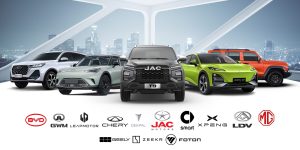Alongside the switch to electric cars, the rapid increase in choice from Chinese brands is the defining trend shaping the automotive world today.
In recent times you may have started seeing MGs, Havals, Cherys and BYDs everywhere you look, and wondered to yourself what might be going on.
There is a sea change going on, with several automotive giants from Shanghai to Shenzhen muscling in on turf previously held by brands from Japan, Korea or Germany.
In the blink of an eye these vehicles have gone from being cars sold solely on price, to vehicles that compete in every aspect – and even lead the market in some.
This is particularly true with EVs, where BYD has become the number-two after Tesla the world over, making its own batteries and even selling them to brands like Kia and Toyota.
Consider MG, which has made the market’s top-selling small SUV and light hatchback for a few years running. Or GWM, which is having great success with its Haval-branded SUVs, Tank-branded 4x4s and Cannon-branded utes.
Naturally, this success has seen other Chinese brands look to our shores for opportunities. And there are so many of them. Australia isn’t so far away from Asia after all, and unlike the USA and Europe, we don’t have domestic production to protect with tariffs.
The avalanche has started now, and that means more choice for car buyers. As we always say to the car brands we work with Cox Automotive Australia, you must not underestimate this.

Let’s put some numbers on the table. In 2024 the Chinese brands BYD, Chery, GWM, LDV and MG sold more than 140,000 cars in Australia, equal to about 12% of the total market. In 2025 we expect this figure will edge close to 20%, meaning one-in-five cars sold.
The five companies mentioned plan to roll out more models and sell more cars this year. But at the same time, we’re preparing for a wave of new arrivals including Geely (which owns Volvo, Polestar and Lotus), Leapmotor, Deepal, Xpeng, JAC – and more.
You’ll find these cars tend to better many of their competitors on price while offering advanced technology – where do you think your giant TV screen and iPhone is made, after all? – offer warranties of up to 10 years, and engage top dealer groups who really know how to sell them.
Moreover, these brands make everything from small hatchbacks to large luxury SUVs, drop-top sportscars, utes and vans, the full spectrum. The rapid improvement in standards means they are increasingly becoming competitive with anyone.
Of course, there are lots of factors to consider. There’s a reason why we all know and trust Ford, Mitsubishi, BMW, etcetera. These are brands with decades-long histories in Australia, who have earned respect and put in the work.
The challenge any emerging brands have is two-fold: Reassuring customers that they will be reliable and more importantly will be there for you if something goes wrong, and ensuring they have competitive resale values for whenever it’s time to sell and buy something new.
But we’ve seen this before. It wasn’t so long ago that people looked down their noses at Korean cars from Hyundai and Kia, and before that the Japanese cars were scoffed at too. If anything, the improvement curve these Chinese brands are showing is even steeper.
Don’t get us wrong, the better-known ‘legacy’ car brands still have a huge amount to offer, and those that move quickly will have a bright future indeed. But tomorrow’s car scene will, without a doubt, include Chinese players as well. And eventually, you may even buy one…


